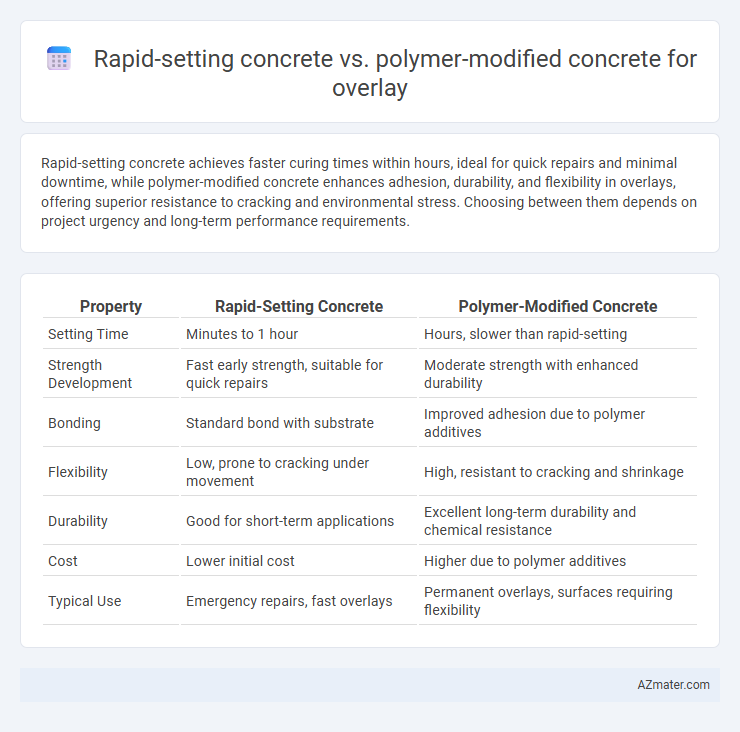Rapid-setting concrete achieves faster curing times within hours, ideal for quick repairs and minimal downtime, while polymer-modified concrete enhances adhesion, durability, and flexibility in overlays, offering superior resistance to cracking and environmental stress. Choosing between them depends on project urgency and long-term performance requirements.
Table of Comparison
| Property | Rapid-Setting Concrete | Polymer-Modified Concrete |
|---|---|---|
| Setting Time | Minutes to 1 hour | Hours, slower than rapid-setting |
| Strength Development | Fast early strength, suitable for quick repairs | Moderate strength with enhanced durability |
| Bonding | Standard bond with substrate | Improved adhesion due to polymer additives |
| Flexibility | Low, prone to cracking under movement | High, resistant to cracking and shrinkage |
| Durability | Good for short-term applications | Excellent long-term durability and chemical resistance |
| Cost | Lower initial cost | Higher due to polymer additives |
| Typical Use | Emergency repairs, fast overlays | Permanent overlays, surfaces requiring flexibility |
Introduction to Concrete Overlays
Concrete overlays serve as a durable solution for resurfacing and rehabilitating existing pavements, enhancing structural integrity and aesthetics. Rapid-setting concrete offers quick strength gain and minimal downtime, making it suitable for urgent repairs and traffic-intensive areas. Polymer-modified concrete improves bond strength, durability, and resistance to cracking, providing a longer-lasting surface in overlay applications.
What is Rapid-Setting Concrete?
Rapid-setting concrete is a type of concrete that achieves initial set within minutes and reaches functional strength typically within one to two hours, making it ideal for quick repairs and overlays where downtime must be minimized. It consists of specialized cementitious materials, accelerators, and admixtures that speed up the hydration process without compromising durability or bond strength. This rapid strength gain is particularly beneficial for roadways, bridges, and industrial floors requiring fast reopening to traffic or service.
What is Polymer-Modified Concrete?
Polymer-modified concrete (PMC) is a composite material enhanced with polymers to improve bonding, durability, and resistance to chemicals and weathering, making it ideal for overlays requiring high performance and longevity. Unlike rapid-setting concrete, which cures quickly for fast project completion, PMC offers superior flexibility and reduced permeability, resulting in enhanced crack resistance and adhesion to existing substrates. These properties make polymer-modified concrete particularly effective in rehabilitation and repair applications where durability and strong surface integration are critical.
Comparative Strength Characteristics
Rapid-setting concrete achieves high early strength within hours, making it ideal for fast repairs and overlays requiring quick return to service. Polymer-modified concrete enhances tensile strength, adhesion, and durability through polymer additives, providing superior resistance to cracking and chemical attack compared to conventional mixes. While rapid-setting concrete excels in rapid strength gain, polymer-modified overlays offer improved long-term performance under dynamic loading and environmental stressors.
Setting Time and Curing Requirements
Rapid-setting concrete achieves initial set within 30 to 60 minutes, enabling faster traffic reopening and reduced downtime, while polymer-modified concrete typically requires 24 to 48 hours to cure before it can bear significant loads. The curing process for rapid-setting concrete is minimal, often only needing moisture retention for a few hours, whereas polymer-modified concrete demands controlled curing conditions like consistent moisture and temperature over several days to maximize bonding and durability. Selecting between the two depends on the project timeline and service conditions, where rapid-setting suits urgent repairs and polymer-modified offers enhanced flexibility and adhesion for overlays.
Durability and Crack Resistance
Rapid-setting concrete offers accelerated curing times ideal for quick repairs, but polymer-modified concrete significantly enhances durability and crack resistance due to its improved bonding and flexibility. Polymer modifiers increase tensile strength and reduce permeability, providing superior resistance to environmental stress and shrinkage-induced cracking. For overlay applications requiring long-term performance under dynamic loads, polymer-modified concrete delivers a more resilient and crack-resistant surface than rapid-setting alternatives.
Bonding Performance to Existing Substrate
Rapid-setting concrete exhibits fast curing times and moderate bonding strength to existing substrates, making it suitable for emergency repairs where quick return to service is crucial. Polymer-modified concrete significantly enhances bonding performance through improved adhesion and flexibility, reducing microcracking and delamination risks on overlays. For optimal long-term durability and superior bond strength, polymer-modified concrete outperforms rapid-setting concrete in overlay applications.
Application Methods and Workability
Rapid-setting concrete offers accelerated curing times ideal for emergency repairs and fast-track projects, with straightforward application using conventional methods such as pouring and finishing, providing high early strength. Polymer-modified concrete enhances workability with superior adhesion and flexibility, applied effectively through troweling or spraying, making it suitable for overlay surfaces requiring improved bond strength and durability. The choice between the two depends on specific project demands for setting time and performance under varying exposure conditions.
Cost Analysis and Economic Considerations
Rapid-setting concrete offers lower initial labor costs due to faster curing times, reducing project downtime and accelerating overlay application. Polymer-modified concrete, while generally more expensive upfront because of additive materials, provides enhanced durability and chemical resistance, potentially lowering long-term maintenance and repair expenses. Evaluating total lifecycle costs, polymer-modified overlays may yield better economic value on heavily trafficked or chemically exposed surfaces despite higher initial investment.
Best Use Cases and Recommendations
Rapid-setting concrete is ideal for time-sensitive overlay projects such as road repairs and emergency pavement restorations where quick curing and early strength gain are critical. Polymer-modified concrete excels in overlays requiring enhanced durability, superior bonding, and resistance to chemical attacks, making it suitable for bridge decks and industrial floors. Selecting between the two depends on project priorities: rapid-setting concrete for fast turnaround and polymer-modified concrete for long-term performance under harsh conditions.

Infographic: Rapid-setting concrete vs Polymer-modified concrete for Overlay
 azmater.com
azmater.com